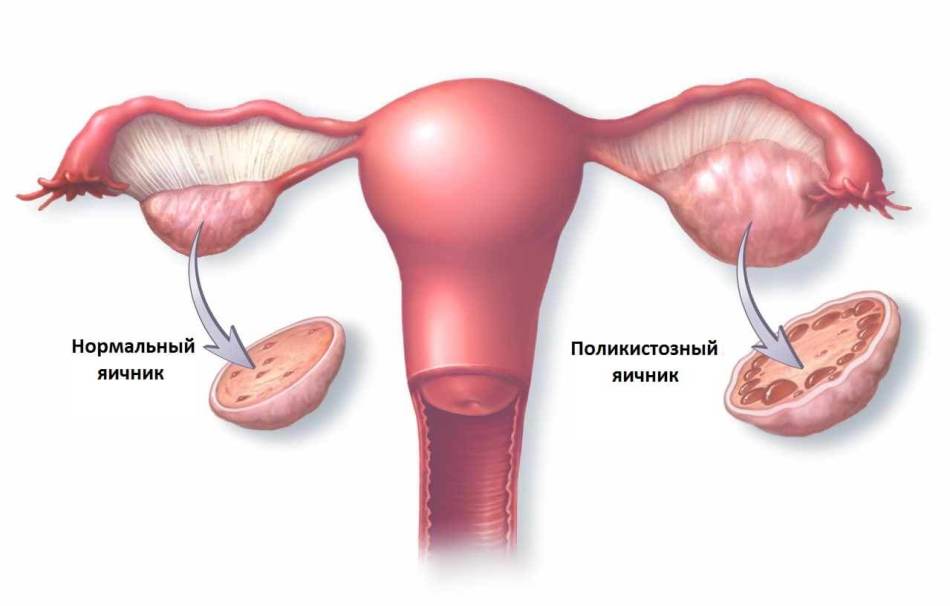The question of the causes of the ovarian cyst and the danger of such a disease is relevant for many women. What treatment is most effective in different types of formations, and what effect this or that intervention has on the subsequent pregnancy - read about this in our article.
Content
- The reasons for the formation of ovarian cysts
- What is the danger of ovarian cysts in women?
- What does the ovarian cyst look like, photo
- Is it possible to delay menstruation with the ovarian cyst?
- Hormonal treatment of ovarian cysts
- Removing the ovarian cyst
- How to treat ovarian cysts with folk remedies?
- Pregnancy after removing the ovarian cyst
- Sports with ovarian cyst
- Prevention of ovarian cysts
- Video: What is the ovarian cyst? Do I need to remove it?
The ovarian cyst is a common disease that is diagnosed in approximately 40% of women of young and middle age. With the onset of the menopause period, the risk of ovarian cysts are significantly reduced - to 6% of cases.
The reasons for the formation of ovarian cysts
- The ovarian cyst is a hollow formation in tissues in the form of a “bag” filled with liquid contents and protruding above the surface of the ovary. The cavity can have a flat base or located on the "leg"
- In 80 % of cases, the development of cystic formation comes from a ripening follicle. During each menstrual cycle in the ovary, one egg is formed, which after ripening comes out of the follicle, falling into the fallopian tube. In this case, the torn follicle is converted into a yellow body
- If there is no gap, the follicle remains in the ovarian tissues and is filled with liquid, forming a cavity. Cyst size can be from 1-2 to 15-20 cm
Such structural disorders and ovarian functions can be caused:
- hormonal malfunctions
- diseases of the endocrine system
- transferred in the past mechanical and surgical interventions (curettage, abortion)

What is the danger of ovarian cysts in women?
- Most often, such a pathology proceeds asymptomatic, but sometimes with large growths it can cause discomfort, exerting pressure on neighboring organs
- Basically, cysts developing against the background of ovulation disorders are absorbed during the next menstrual cycle and do not require additional treatment
- The danger is those cases when the legs are twisted or the rupture of cysts leading to the formation of internal bleeding with pain symptoms and the risk of blood poisoning. Some types of cysts can grow into malignant formations

The following types of cysts are distinguished:
- Yellow body cyst - It is formed if the follicle after the onset of ovulation is filled with yellowish liquid, sometimes with blood interspersed. The size of the cavity is up to 4-6 cm. Sometimes the process proceeds completely asymptomatic with the reverse development of formation within 2 months. If the size of the cyst is large enough, as well as in the case of its rupture, surgical removal is carried out
- Follicular cyst It is formed if ovulation does not occur. Then the liquid accumulates in an underdeveloped follicle. The size of the cyst in diameter usually does not exceed, 8 cm. Surgical intervention is required if there is a rupture, twist, hemorrhage
- Pararic cyst It is more often diagnosed in young women under the age of 30 and develops in the field of ovarian appendages. Such an education has a size of K to 10, sometimes up to 20 cm. With large sizes, the cyst can provoke pulling pains in the abdomen and appendages, a feeling of fullness and bursting of the intestines and bladder. In this case, it is recommended to remove the formation by laparoscopy
- Dermoid cyst - A benign tumor formation, which is a thick -walled capsule, inside which various rudimentary cells and tissues of the body are enclosed. The size of the cyst increases quite slowly, when twisting the legs, symptoms in the form of acute pain in the abdomen and lower back may appear. Such pathologies are removed promptly with the maximum possible preservation of the volume of tissue and ovarian function. Such formations are dangerous in that they can develop into oncological
- Endometrioid cyst - Development occurs due to the growth of endometrium tissues in the ovaries, which normally should lift the internal cavity of the uterus. Education growth occurs with each menstrual cycle. The symptom of this pathology is a constant pulling pain in the lower abdomen and lower back, which intensifies to the days of menstruation. This type of formation is characterized by inflammatory processes in the organs of the genitourinary system and pelvis, impaired function of the bladder and organs of the gastrointestinal tract-constipation, increased gas formation, and rapid urination
What does the ovarian cyst look like, photo

Is it possible to delay menstruation with the ovarian cyst?
- The regularity of the menstrual cycle and the nature of monthly discharge directly depend on the presence of a follicular cyst. The egg that has not come out of the follicle provokes the production of hormones that cause a delay in menstruation. The delay period can be from 5-7 days to a month and is associated with a significant level of hormones if it is impossible to ovulate
- If the size of education has already reached 6-8 cm, the following symptoms may appear that have not been observed earlier:
Abundant discharge, the intensity of which remains during all days of menstruation - Duration - discharge is observed for more than 7 days
Painful sensations - the presence of pain not only in the lower abdomen and the sacrum, but also in the side, from the side of the localization of the cyst - Scarious discharge of brownishness is also possible - this is due to a decrease in the production of hormones of progesterone and estrogen

Hormonal treatment of ovarian cysts
- Hormonal therapy is an effective tool if the cause of the cyst is a violation of the hormonal background. This treatment method is used in the case of diagnosing a functional cyst (follicular, yellow body cyst)
- The choice of the necessary hormonal drug is made by the attending physician individually for each patient after ultrasound, establishing the general picture of the course of the disease and collecting the necessary tests
- Typically, hormonal treatment is comprehensively complemented by physiotherapeutic procedures, acupuncture and drugs to restore and increase the function of the immune system
- If in the process of treatment (Z-4 months) there is no complete resorption of the neoplasm, surgical treatment is prescribed

Removing the ovarian cyst
Indications for the need for an operation to remove cysts are:
- The presence of a neoplasm of any genesis that has existed for at least months and has not resilient independently or during hormonal and anti -inflammatory treatment.
- Neoplasm in the form of a tumor that appeared during the onset of menopause
- Development or risk of complications - diagnosis of twisting, hemorrhage, rupture, inflammation and suppuration of the cyst
- Suspicion of tissue degeneration into malignant education
The volume and type of surgical intervention in order to remove the ovary cyst is solved strictly individually at the stage of examination of the patient, taking into account the nature of the education, its size and localization.
- The operation can be carried out in an open way or using endoscopic access methods - laparoscopic or laparotomic, followed by histological analysis of extracted tissues
- If in the course of preoperative preparation the probability of malignant education is not confirmed, taking into account the age of the woman, the organ -preserving removal of the cyst is performed by hatching or resection of the ovary
- In case of suspicion of the oncological nature of the formation, a radical method is proposed - the removal of ovarian appendages (sometimes along with the uterus). This procedure can also be carried out by laparoscopy

How to treat ovarian cysts with folk remedies?
Treatment of ovarian cysts must be carried out under the control of a specialist. With the consent of the doctor, you can also use folk prescriptions that have proven themselves in the treatment of female genital diseases.
Boron uterus, red brush, winter -lover - These healing herbs have long helped women in the treatment of endometriosis, myoma, severe menopause, mastopathy and even infertility. The biologically active substances contained in the composition of plants are better in the complex, so for treatment it is necessary to prepare decoctions of herbs and take them according to the scheme.
To prepare a decoction, take 1 tsp. Dry grass, pour 250 ml of boiling water, leave to infuse for about half an hour. Start the course of treatment immediately after the end of menstruation:
- 1st week-take 100 ml of a warm decoction of the bore uterus with the addition of 1 tbsp. l. natural honey s times a day a day before meals
- 2nd week-drink a decoction of a red brush in the same volume
- 3rd week-drink a decoction of wintering in the same volume
Further, during menstrual days, you need to take a break, and then repeat the course (treatment can be carried out before Z-4 \u200b\u200bmonths)
Burdock (burdock) - The juice of this plant contains a large number of substances that are useful to the body, in particular phytosterin, which promotes the absorption of benign formations and cysts, as well as the suppresses of the division of oncellites.
You can prepare the healing juice of the burdock as follows: dry the fresh leaves with a napkin, chop in a blender and squeeze through gauze or use a juicer. You need to store juice in the refrigerator in a glass dish for no more than 2 days.
The course of treatment is carried out after the end of menstruation according to the following scheme:
- 1st and 2nd day-twice a day for 1 tsp. before eating
- 3rd and 4th day-z, 1 tsp.
- from the 5th day to the beginning of the next menstrual cycle-z times a day, 1 tbsp. l.
Repeat the treatment during 2 cycles.
Green walnuts They contain a large number of alkaloids - substances for the effective treatment of various kinds of neoplasms. It is best to collect young nuts during the end of spring - early summer, while they are still soft.
- To prepare the tincture, wash the nuts well, cut it, fold into a glass liter container to fill it into ¼ part. Then add alcohol or vodka until the can fill, close tightly and leave in a cool place without access to sunlight for 5-6 weeks. Shake the contents well once a week
- Strain the finished tincture and store in the refrigerator. Drink 1 tbsp. l. Z times a day before meals for Z-4 months
An equally useful tool is a mixture of honey and green walnuts. This composition is also useful for the prevention of benign formations, while cleansing and strengthens the body as a whole.
- Mix 500 g of chopped nuts and 500 g of liquid natural honey in glass bowl. Leave the mixture for 1.5-2 months in a cool place (do not clog the container too tightly)
- Then strain honey syrup and take 1 tsp. Z times a day for a long time

Pregnancy after removing the ovarian cyst
- The presence of ovary cysts does not directly affect the detorial function. But, as already noted, cystic formations are associated with violation of the ovulatory cycle. Therefore, if a woman cannot get pregnant, an ultrasound examination of the genitals is prescribed, since the ovarian cyst is suspected
- After removing the cyst with a surgical method, as a rule, the ovarian function is preserved. To prevent the adhesive process, it is recommended to get up and move the very next day after surgery. Since the intervention is minimal, painful signs are absent or insignificant
- Normal pregnancy and childbirth after surgery are possible subject to all the recommendations of the doctor, which may include: taking the necessary drugs, compliance with a special diet, physiotherapy exercises, compliance with hygiene rules
- In the case of a large -sized benign formation or bilateral localization of the cyst, the operation can lead to a significant decrease in ovarian tissue and infertility. In such situations, experts can be recommended by the selection of eggs before the operation for the possibility of further extractoric fertilization

Sports with ovarian cyst
- Moderate physical activity is useful for maintaining female health. They contribute to the normalization of cardiovascular and respiratory activity, improve blood circulation and nutrition of oxygen cells, help accelerate metabolism and burn fat deposits, and support the overall muscle tone
- When diagnosing the ovarian cyst, you need to get a doctor’s consultation about the possibility of playing sports and permissible loads
- If the ovary cyst is formed due to the development of the inflammatory process, sports should be temporarily excluded to prevent complications. Some types of sports exercises can lead to an increase or breakdown
- After treatment, it is necessary to avoid classes with an intensive or shock load on the pelvic area - exercises on the press, strength exercises on the abdominal muscles, sharp inclinations and turns of the body, and eastern martial arts.
The following sports will be optimal:
- Exercise therapy - is often a mandatory stage of therapy, especially if violations of the hormonal background are associated with the presence of overweight. Classes can be built by combining exercises of various intensities - elements of mild gymnastics and gym loads
- Sports walk - this type of physical activity is safe, helps strengthen the spine, eliminate congestion in the pelvic organs and increase blood circulation
- Jogging (jogging) is a healing run. Is an effective sport to maintain muscle tone and fat burning
- Yoga classes in combination with breathing gymnastics - for various periods of the cycle, there are special practices aimed at strengthening the female reproductive system and accumulating energy

Prevention of ovarian cysts
The best prevention of this disease is a mandatory gynecological examination by a woman once every six months. Any changes in the structure of the genitals, infectious diseases and the accompanying inflammatory processes are succumbing to effective and full treatment when detected in the early stages.






